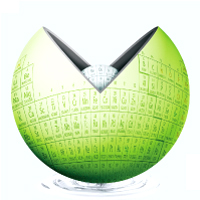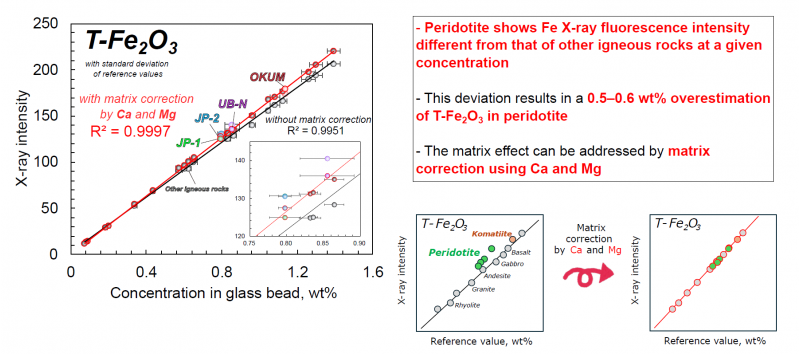
Accurate determination of whole-rock major element composition of ultramafic rocks through X-ray fluorescence spectrometry
ABSTRACT

The whole-rock composition of peridotites is essential for understanding geological processes related to the Earth’s mantle. X-ray fluorescence (XRF) analysis employing glass beads is the most common method to determine the chemical composition of igneous rocks because of its simplicity and efficient decomposition of refractory minerals. The accuracy of the XRF analysis using a multipoint calibration curve depends on the matrix effects and the reference values in the reference materials (RMs) used. In the quantitative analysis of peridotites, the limited availability of certified ultramafic RMs necessitates the incorporation of other igneous rocks into the calibration curve (along with a small number of ultramafic RMs), leading to potential systematic biases. In this study, we propose a robust approach to obtain accurate major element concentrations in ultramafic rocks. Specifically, we examine (1) the difference in the X-ray fluorescence intensity of total iron (T-Fe2O3) relative to the concentration between peridotite and other igneous rocks, and (2) the selection of the reference values in RMs for the quantification of Cr2O3. We found that the matrix correction using Ca and Mg improves the T-Fe2O3 calibration curve, and the quantified T-Fe2O3 concentrations of peridotite and basalt using the corrected calibration curve are consistent with the certified values in RMs. T-Fe2O3 concentration in peridotite could be overestimated by ~0.5–0.6 wt% without matrix correction. In contrast, NiO and other major elements exhibit minimal matrix effects; the accuracy of their calibration curve depends on the variation of reference values in RMs. For Cr2O3, peridotite RM JP-1 is the most critical because of its highest Cr concentration among the calibration standards, and its recent analyzed value provided by the Geological Survey of Japan (GSJ) was used to optimize the accuracy of the calibration curve. The proposed correction of matrix effect and reference values in RMs in the analysis of peridotite enhances quantification accuracy and improves our understanding of the Earth’s mantle geochemistry.
KEYWORDS
Keywords: ultramafic rock, peridotite, X-ray fluorescence, iron, matrix effect, reference material- Published : 2025
- Released on J-STAGE : -
- Received : 2025/05/09
- Accepted : 2025/10/19
- DOI : https://doi.org/10.2343/geochemj.GJ25017
- J-STAGE URL : https://www.jstage.jst.go.jp/article/geochemj/advpub/0/advpub_GJ25017/_article/-char/en
- J-Online ISSN: 1880-5973
- Print ISSN : 0016-7002
- ISSN-L : 0016-7002
All Issues
- Vol.59, 2025
- Vol.58, 2024
- Vol.57, 2023
- Vol.56, 2022
- Vol.55, 2021
- Vol.54, 2020
- Vol.53, 2019
- Vol.52, 2018
- Vol.51, 2017
- Vol.50, 2016
- Vol.49, 2015
- Vol.48, 2014
- Vol.47, 2013
- Vol.46, 2012
- Vol.45, 2011
- Vol.44, 2010
- Vol.43, 2009
- Vol.42, 2008
- Vol.41, 2007
- Vol.40, 2006
- Vol.39, 2005
- Vol.38, 2004
- Vol.37, 2003
- Vol.36, 2002
- Vol.35, 2001
- Vol.34, 2000
- Vol.33, 1999
- Vol.32, 1998
- Vol.31, 1997
- Vol.30, 1996
- Vol.29, 1995
- Vol.28, 1994
- Vol.27, 1993
- Vol.26, 1992
- Vol.25, 1991
- Vol.24, 1990
- Vol.23, 1989
- Vol.22, 1988
- Vol.21, 1987
- Vol.20, 1986
- Vol.19, 1985-1986
- Vol.18, 1984
- Vol.17, 1983
- Vol.16, 1982
- Vol.15, 1981
- Vol.14, 1980
- Vol.13, 1979
- Vol.12, 1978
- Vol.11, 1977
- Vol.10, 1976
- Vol.9, 1975
- Vol.8, 1974
- Vol.7, 1973
- Vol.6, 1972-1973
- Vol.5, 1971
- Vol.4, 1970-1971
- Vol.3, 1969-1970
- Vol.2, 1968
- Vol.1, 1966-1967




